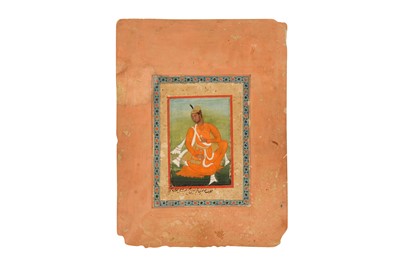28th Oct, 2022 14:00
Islamic & Indian Art
A SEATED PORTRAIT OF A DECCANI PRINCE, PROBABLY ALI ADIL SHAH II (1657–1672) OF BIJAPUR
Possibly Bijapur, Deccan, Central India, 18th century
A SEATED PORTRAIT OF A DECCANI PRINCE, PROBABLY ALI ADIL SHAH II (1657–1672) OF BIJAPUR
Possibly Bijapur, Deccan, Central India, 18th century
Opaque pigments and ink heightened with gold on paper, the vertical composition portraying a young dark-skinned prince clad in a bright orange robe with a golden sash around his waist and a long white scarf around his chest and shoulders, holding a small wine cup in his hand, hanging from his golden sash two encrusted golden hooks attached to a small golden bag, mounted on a later buff-coloured cardboard album page and set within concentric polychrome-painted decorative borders, a black ink Arabic free-flowing naskh inscription at the bottom reading the honorific title of Hazrat-e Mowla Fahruddin Saheb Qods Allah ... al-Arabi, the back with numbers in pencil and pen in different hands, 33cm x 25cm.
The Adil Shahi dynasty was a short-lived line of Shia (and later Sunni) rulers in the Deccan, which was founded by Yusuf Adil Shah in 1489 (r. 1490–1510), a Bahmani governor who proclaimed the independence of the Bijapur state and appointed himself as the ruler of the newly-founded Sultanate. Bijapur had been a thriving province of the Bahmani Sultanate (1347 - 1518) for almost 150 years before gaining its independence, and the potential of this rich state was soon going to attract the interest of the Mughal emperors, especially Aurangzeb, who launched a campaign to include the state in the Mughal Empire and eventually conquered Bijapur on 12 September 1686.
Among the various Adil Shahis, the two most renowned rulers are Ibrahim Adil Shah II (1580 - 1627) and Ali Adil Shah II (1657 - 1672). They were great patrons of the arts and adorned Bijapur with palaces, mosques, and mausoleums, considered to be some of the finest examples of Deccan Sultanate and Indo-Islamic Architecture. The suggested attribution of the present miniature to Ali Adil Shah II stems from the comparison of the present sitter's robe and attire with a number of well-known portraits depicting this ruler. Indeed, it seems that Ali Adil Shah II was particularly fond of brightly coloured robes, especially in the tones of orange, saffron, and ochre.
In the Witsen Album, a collection of 49 miniatures of Mughal rulers and Indian noblemen painted in Golconda in the late 17th century and now part of the Rijksmuseum (inv. no. RP-T-00-3186), Ali Adil Shah II is portrayed wearing a bright orange long robe with a gem and pearl-encrusted sash around his waist and a tall black heron aigrette. Similar attires in the tones of orange and saffron can be seen on two portraits of the ruler in two different albums at the British Museum (inv. nos. 1974,0617,0.4.27 and 1974,0617,0.2.56). In a durbar painting exhibited at the Metropolitan Museum of Art in New York in 2015 during the exhibition "Sultans of Deccan India, 1500–1700: Opulence and Fantasy", Ali Adil Shah is showing off a bright yellow long robe and a striped burgundy and gold overcoat. Moreover, each of these portraits presents the ruler wearing a golden turban decorated with a black heron aigrette, another feature matching the outfit of our sitter. It seems therefore plausible to suggest that the prince depicted in our lot could be a young Ali, prior to his time as a ruler of the Bijapur Sultanate.
Sold for £17,500
Includes Buyer's Premium
Do you have an item similar to the item above? If so please click the link below to submit a free online valuation request through our website.




